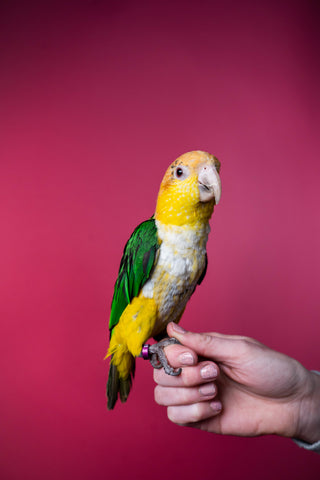
I am really uncomfortable meeting other people’s birds when I see that the human companion doesn’t hold the bird’s feet when they have them on their hand. Usually the person will have the bird loose on its arm, towards the middle of the arm or something where the person has no control over the bird whatsoever.
Too many times has a bird been spooked or upset, and flown at someone. The owner at that point can’t really do much because good luck catching up with a flighted (or in some cases just pure determined) parrot!
I keep my distance if I realize the person has no control over the bird they have. You can usually tell pretty quick who is in charge; person or bird.
We always train people, especially those doing our freeflight course, the important of holding your bird’s feet. The biggest reason we do this with our birds is how much easier it makes it to read the parrot’s mood or pick up on subtle body language. You can feel everything in your bird’s feet… every mood change, every little thing that is setting them off or starting to make them feel uneasy.
The simple act of shifting weight or a slight lean can be felt through your bird’s feet and can say so much. You can foresee situations coming and avoid disaster or freak outs. You can also keep your bird in one place and have time to calm it down should it become upset, without having it flail around and possibly get hurt. It’s also a good way to move your bird from one place to another, and is how we transfer our birds when having to go outside without a travel carrier or harness (from house to aviary – and be cautious as accidents happen and you may not always have your bird’s feet as well as you think you do!)
I’m very comfortable in socializing situations with my birds as long as they are on my hand and I have their feet because I know I know what my bird is feeling like and how to best handle the situation.
Sometimes I have someone approach me with wacky clothing or accessories that make my birds a little leary and they’ll lean just slightly at the sight of it. Feeling that, I know to either move my bird to my hand furthest away or hold the bird farther away than normal, or put myself in between that object and my bird until I feel them be less tense and get used to it. It makes desensitizing and socializing a breeze because you become so in tune to your bird and your bird in turn feels more comfortable in those situations with you knowing you will take care of it and be dialed into their feelings and discomforts.

To train your bird to let you allow his feet to be held you can do through a few days. If your bird is fully flighted you can use flight training to teach it by having the bird land in your hand and closing your hand over its feet while you treat the bird and set him down.
When holding feet you don’t want to cause your bird to fight it, you want to reward your bird for being okay with it and not push it too far. You will start with getting your bird used to being in your hand and slowly closing your fingers over its toes while rewarding. Some birds may want to use one foot to eat their reward, in this case close your fingers around your bird’s feet for a second and set him down on a perch to get the reward. Then have him come to your hand again and continue to extend the length of time that your fingers are over your bird’s feet to eventually getting to the point where you can put some pressure on the feet.
Once you’re there you can start moving with the bird (baby steps, remember!) don’t go too fast or your bird will become scared. Again, you don’t want your bird fighting it, you want to reward them when they are content so work with small, small approximations. When you start moving with your bird you will need to merely lean or move your hand and not the rest of your body and then reward for a job well done of not freaking out.
The key to a successful training session is ending the session before the bird does, ending on a positive note, and keeping the training fun (and SHORT) for your bird so you leave him wanting more and looking forward to the next!



Be the first to comment